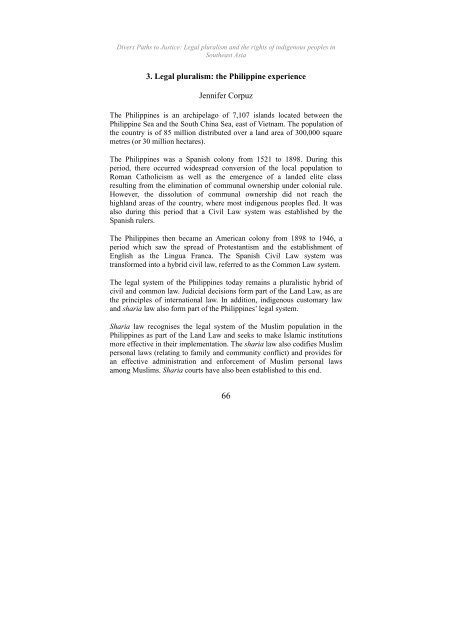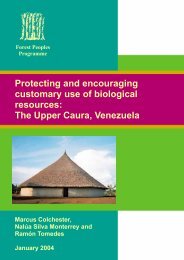Divers Paths to Justice - English - Forest Peoples Programme
Divers Paths to Justice - English - Forest Peoples Programme
Divers Paths to Justice - English - Forest Peoples Programme
Create successful ePaper yourself
Turn your PDF publications into a flip-book with our unique Google optimized e-Paper software.
<strong>Divers</strong> <strong>Paths</strong> <strong>to</strong> <strong>Justice</strong>: Legal pluralism and the rights of indigenous peoples inSoutheast Asia3. Legal pluralism: the Philippine experienceJennifer CorpuzThe Philippines is an archipelago of 7,107 islands located between thePhilippine Sea and the South China Sea, east of Vietnam. The population ofthe country is of 85 million distributed over a land area of 300,000 squaremetres (or 30 million hectares).The Philippines was a Spanish colony from 1521 <strong>to</strong> 1898. During thisperiod, there occurred widespread conversion of the local population <strong>to</strong>Roman Catholicism as well as the emergence of a landed elite classresulting from the elimination of communal ownership under colonial rule.However, the dissolution of communal ownership did not reach thehighland areas of the country, where most indigenous peoples fled. It wasalso during this period that a Civil Law system was established by theSpanish rulers.The Philippines then became an American colony from 1898 <strong>to</strong> 1946, aperiod which saw the spread of Protestantism and the establishment of<strong>English</strong> as the Lingua Franca. The Spanish Civil Law system wastransformed in<strong>to</strong> a hybrid civil law, referred <strong>to</strong> as the Common Law system.The legal system of the Philippines <strong>to</strong>day remains a pluralistic hybrid ofcivil and common law. Judicial decisions form part of the Land Law, as arethe principles of international law. In addition, indigenous cus<strong>to</strong>mary lawand sharia law also form part of the Philippines’ legal system.Sharia law recognises the legal system of the Muslim population in thePhilippines as part of the Land Law and seeks <strong>to</strong> make Islamic institutionsmore effective in their implementation. The sharia law also codifies Muslimpersonal laws (relating <strong>to</strong> family and community conflict) and provides foran effective administration and enforcement of Muslim personal lawsamong Muslims. Sharia courts have also been established <strong>to</strong> this end.66
















